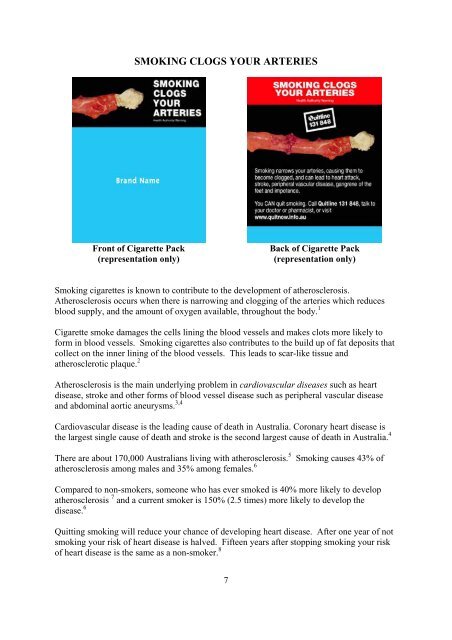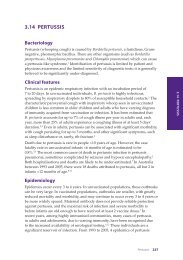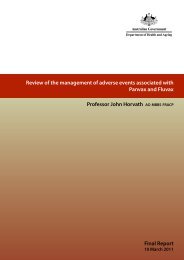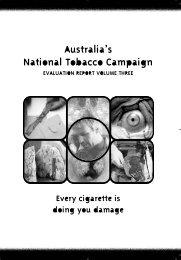SMOKING CLOGS YOUR ARTERIES - Graphic tobacco ... - Quit Now
SMOKING CLOGS YOUR ARTERIES - Graphic tobacco ... - Quit Now
SMOKING CLOGS YOUR ARTERIES - Graphic tobacco ... - Quit Now
You also want an ePaper? Increase the reach of your titles
YUMPU automatically turns print PDFs into web optimized ePapers that Google loves.
<strong>SMOKING</strong> <strong>CLOGS</strong> <strong>YOUR</strong> <strong>ARTERIES</strong><br />
Front of Cigarette Pack<br />
(representation only)<br />
7<br />
Back of Cigarette Pack<br />
(representation only)<br />
Smoking cigarettes is known to contribute to the development of atherosclerosis.<br />
Atherosclerosis occurs when there is narrowing and clogging of the arteries which reduces<br />
blood supply, and the amount of oxygen available, throughout the body. 1<br />
Cigarette smoke damages the cells lining the blood vessels and makes clots more likely to<br />
form in blood vessels. Smoking cigarettes also contributes to the build up of fat deposits that<br />
collect on the inner lining of the blood vessels. This leads to scar-like tissue and<br />
atherosclerotic plaque. 2<br />
Atherosclerosis is the main underlying problem in cardiovascular diseases such as heart<br />
disease, stroke and other forms of blood vessel disease such as peripheral vascular disease<br />
and abdominal aortic aneurysms. 3,4<br />
Cardiovascular disease is the leading cause of death in Australia. Coronary heart disease is<br />
the largest single cause of death and stroke is the second largest cause of death in Australia. 4<br />
There are about 170,000 Australians living with atherosclerosis. 5 Smoking causes 43% of<br />
atherosclerosis among males and 35% among females. 6<br />
Compared to non-smokers, someone who has ever smoked is 40% more likely to develop<br />
atherosclerosis 7 and a current smoker is 150% (2.5 times) more likely to develop the<br />
disease. 6<br />
<strong>Quit</strong>ting smoking will reduce your chance of developing heart disease. After one year of not<br />
smoking your risk of heart disease is halved. Fifteen years after stopping smoking your risk<br />
of heart disease is the same as a non-smoker. 8
Your risk of stroke also decreases after quitting. Between five and 15 years after quitting your<br />
risk of having a stroke is the same as a non-smoker. 1<br />
Men who smoke are also more likely to develop impotence than non-smokers, due to reduced<br />
blood flow to the penis caused by atherosclerosis. Even without atherosclerosis, smoking can<br />
lead to the temporary constriction of blood vessels (vasoconstriction) which also reduces<br />
blood flow to the penis. 2<br />
Also see the fact sheet on peripheral vascular disease for more information.<br />
Decided to quit smoking? For help, talk to your doctor, pharmacist or call the <strong>Quit</strong>line on<br />
131 848 or visit the <strong>Quit</strong>line web site at www.quitnow.info.au.<br />
Sources<br />
1. U.S. Department of Health and Human Services. The Health Consequences of Smoking: what it means to you. U.S.<br />
Department of Health and Human Services, Centres for Disease Control and Prevention, National Centre for Chronic<br />
Disease Prevention and Health Promotion, Office on Smoking and Health, 2004.<br />
http://www.cdc.gov/<strong>tobacco</strong>/sgr/sgr_2004/consumerpiece/index.htm<br />
2. American Council on Science and Health. Cigarettes: What the warning label doesn’t tell you. Second edition. New York,<br />
American Council on Science and Health, 2003.<br />
3. Heart Foundation Cigarette Smoking information sheet, 2002.<br />
http://www.heartfoundation.com.au/downloads/Cigarette_Smoking_Aug_2002.pdf<br />
4. Australian Institute of Health and Welfare (AIHW) 2004. Heart, stroke and vascular diseases – Australian facts 2004.<br />
AIHW Cat. No. CVD 27. Canberra: AIHW and National Heart Foundation of Australia (Cardiovascular series No. 22).<br />
http://www.aihw.gov.au/publications/cvd/hsvd04/hsvd04.pdf<br />
5. ABS National Health Survey 2001 (AIHW analysis)<br />
6. English & Holman et al. (1995). The quantification of drug caused morbidity and mortality in Australia 1992 edition.<br />
Canberra. AGPS<br />
7. Holman & Armstrong et al. (1990). The quantification of drug caused morbidity and mortality in Australia 1988.<br />
Canberra: AGPS<br />
8. Smoking Cessation Guidelines for Australian General Practice. 2004 Edition.<br />
http://www.health.gov.au/internet/wcms/publishing.nsf/Content/health-pubhlth-publicat-document-smoking_cessationcnt.htm/$FILE/smoking_cessation.pdf<br />
8







